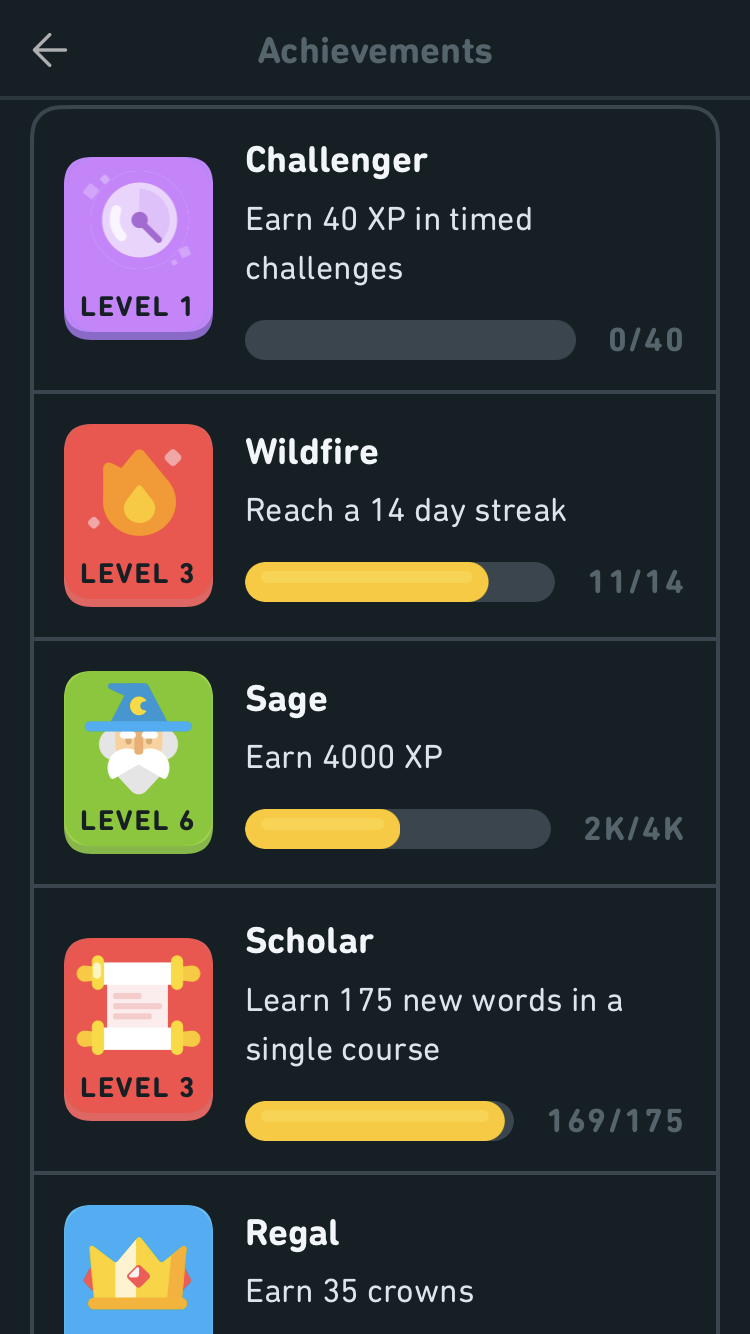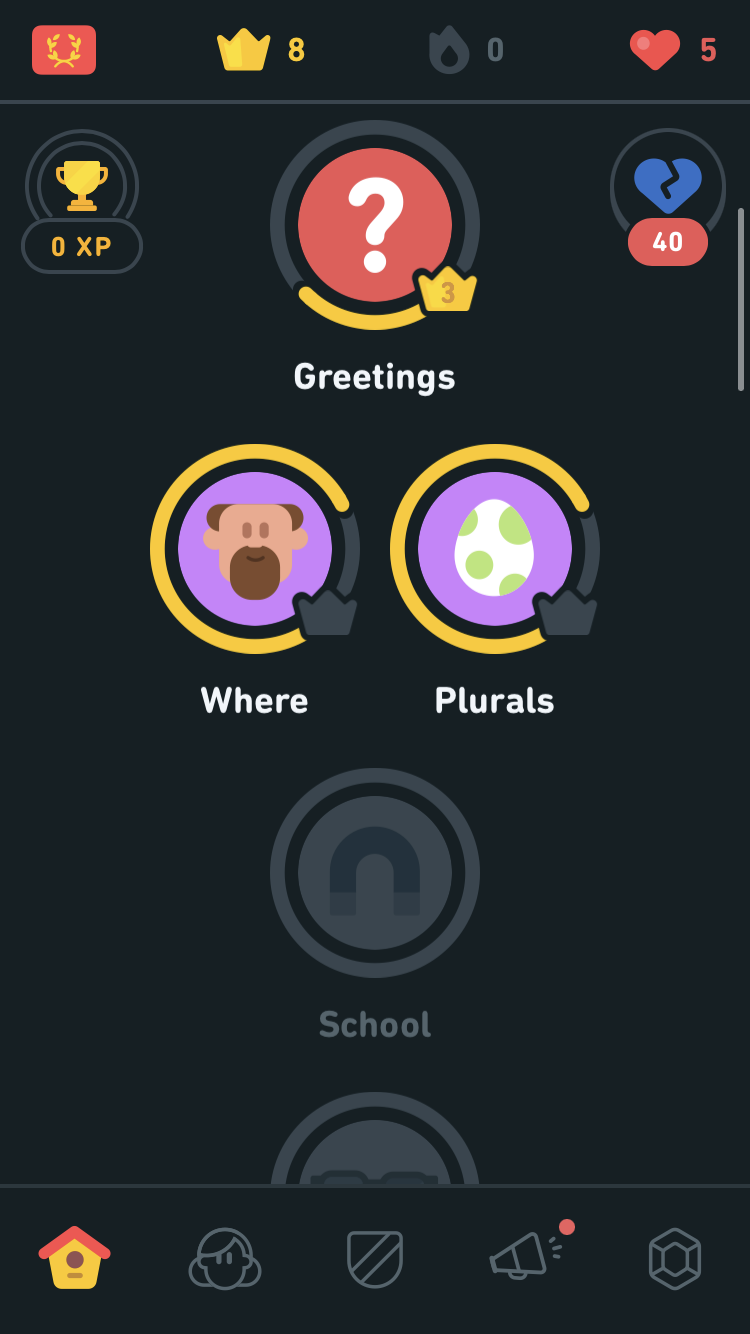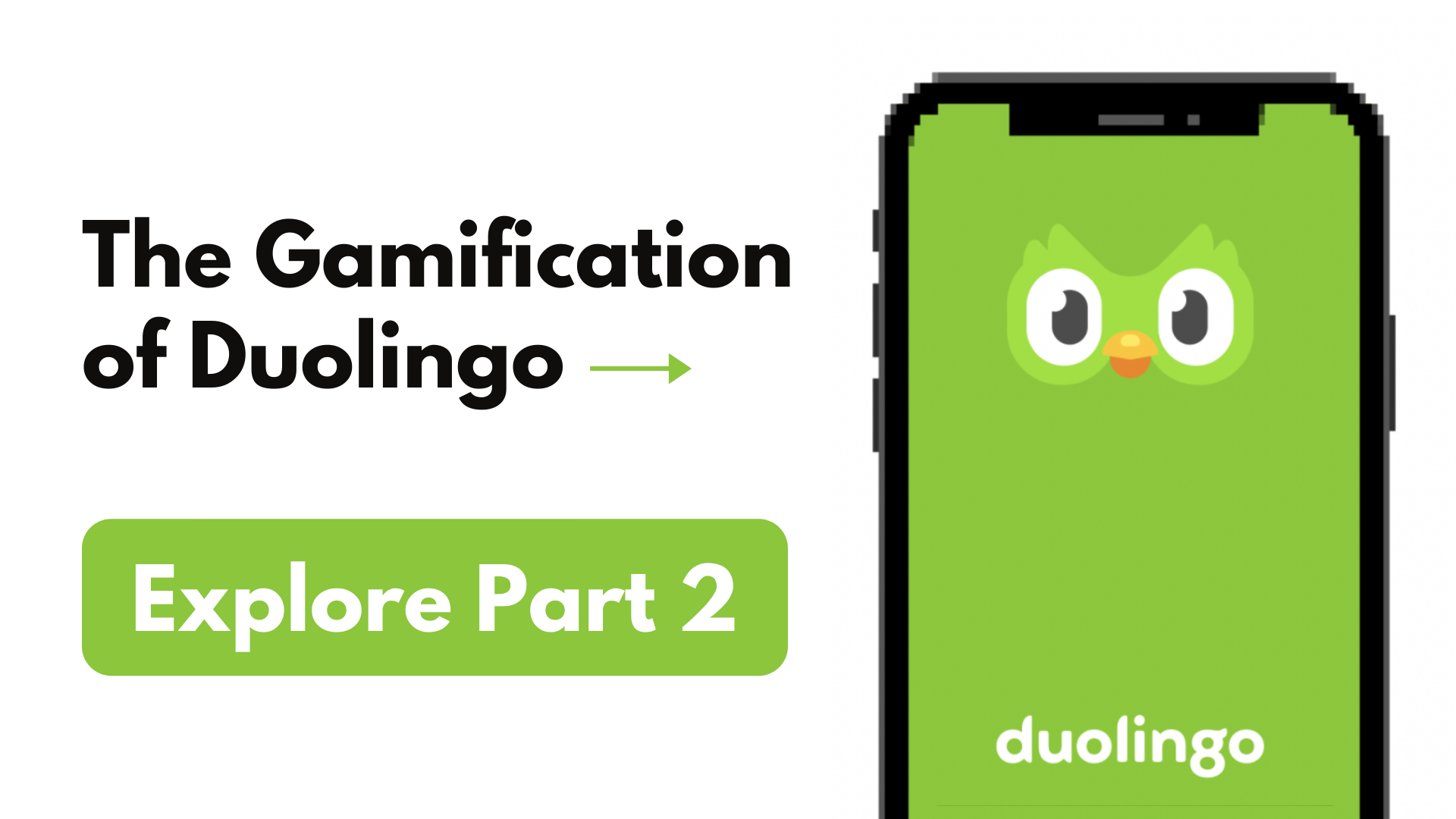















Hi there, my name is Trio and in this free Habit Weekly PRO case study, I'll help you to become a Gamification master!

What makes good and bad gamification
5.
4.
1.
2.
3.
Designing for different playstyles
What are failure states?
How to improve social experiences using gamification
Downloadable Cheat Sheet 🎁
Case Study Overview




In this case study we'll be taking a close look at the language learning app, Duolingo!












You may know my brother, Duo, Duolingo's mascot. Our relationship has been a bit rocky ever since he stole that job from me...










But now I get to spill his secrets to wonderfully curious people, so it all works out in the end, as they say!














There are countless blogs, talks, podcasts, and videos praising Duolingo's gamification techniques.








But, I'm going to take a different approach. First I'll talk a little bit about what Duolingo does well. But then we'll see some of the ways Duolingo actually fails to engage its users!











On our way, we'll encounter mystical artifacts that will help us on our journey to decipher Duolingo's secrets.








?
?
?
?




That second one is a particular mystery. It could be anything!








?
?
?
?




Let's start our journey! Hmm, what could be beyond that strange door!?





LEVEL 1


Level 1
WHAT MAKES GOOD GAMIFICATION?



















This is one creepy castle. I hope those ghosts are friendly...




















Hey there, I'm Fred. That up there is Anne. Welcome to our humble abode.




















Feel free to take that book over there and then monologue for a while, if that's your thing.
Mi casa es su casa.


















Our first artifact! Thank you Fred and Anne!

TOME OF GAMIFICATION ACQUIRED























It turns out not all ghosts are scary! Some help you gain the knowledge to give an informed case study monologue. Now let's open this book and see what it says.




















Gamification as a term covers a lot of ground, but is usefully defined as 'A motivation and engagement strategy that utilizes elements and techniques from game design in non-game contexts.'





















When you think about gamification, you probably think about points, badges, and leaderboards. But these game elements are hardly the end-all be-all of gamification design.





















They can be useful in the right context, but if done poorly, they can make your user design crowded and unusable.






























Luckily, the tome has a nice gamification checklist to make applying gamification effectively easier!




















Follow these tenets to implement effective gamification...


Gamification Tenets




















1) Understand your players.


1) Understand your players.
Gamification Tenets




















This principle boils down to knowing your users' goals, preferred playing styles, and why they are using your platform in the first place.

1) Understand your players.
Gamification Tenets




















For Duolingo, their audience is people who want to learn a new language. But, there are many reasons why someone may want to do so, and different levels of commitment that people are willing to give.

1) Understand your players.
Gamification Tenets




















We will touch back on this later, but understanding user motivation plays a big part in designing effective gamification.

1) Understand your players.
Gamification Tenets



















2) Game design elements should be context-relevant.


1) Understand your players.
2) Game design elements should be context-relevant.
Gamification Tenets






















This is a wise, albeit concise, book. Adding game elements to a non-game context can be very tricky. You have to make sure that the elements you're adding are appropriate for the context.

1) Understand your players.
2) Game design elements should be context-relevant.
Gamification Tenets




















For example, leaderboards, a public and competitive element, wouldn't make much sense in a private or cooperative setting. And it may even backfire if used for something like comparing employees within a company or students within a classroom.

1) Understand your players.
2) Game design elements should be context-relevant.
Gamification Tenets




















3) All game elements should serve a purpose.


1) Understand your players.
2) Game design elements should be context-relevant.
3) All game elements should serve a purpose.
Gamification Tenets




















Gamification is most effective when the game design elements have a purpose and all support the end-goal of your user experience.


1) Understand your players.
2) Game design elements should be context-relevant.
3) All game elements should serve a purpose.
Gamification Tenets



















For instance, Duolingo's gamification elements each serve the purpose of getting their users to open the app and complete a lesson or two every single day.


Gamification Tenets
1) Understand your players.
2) Game design elements should be context-relevant.
3) All game elements should serve a purpose.



















Duolingo's version of badges, "achievements", reward certain accomplishments. Things like reaching a daily streak of a certain length, learning a certain number of words, or gaining a bunch of experience points.






















And Duolingo gives experience points for completing lessons, then compares you with other users in a timed leaderboard to see who can earn the most within a week.






















They even have lives (hearts) that disappear when you make a mistake, and only replenish after several hours have passed.






















All of these elements encourage repeated, daily visits to the app, and they are pretty effective at that goal.






















Beyond these stereotypical game elements, Duolingo also completely embraces a fantasy game aesthetic.




















When you complete a lesson you are rewarded with a wooden chest, and in that chest are a semi-random number of gems, and those gems can be used to buy things like amulets that protect your daily streak.






















This makes the whole app experience feel light-hearted and fun. You aren't working to learn a language, you're playing a game that happens to teach you one! It's a popular app for good reason.






















But, now that we've seen what Duolingo does well, I want to break up the party and explore some of the ways it fails to use game design to engage its users.




















Game elements like points and badges provide extrinsic motivation, meaning they motivate a behavior to obtain the points or badges rather than out of interest in the behavior itself.




















Duolingo does well with game elements that reinforce extrinsic motivation. On the other hand, intrinsic motivators are lacking. So how do you build intrinsic motivators into an effective user experience?




















I'd love to know the answer to that! Unfortunately, the in-laws are coming over and we haven't put up the cobwebs yet. Would you mind continuing on your way?





















Ok, let's move on. That portal is a bit ominous... But, what is life without a little adventure?

LEVEL 2
Level 2
DESIGNING FOR DIFFERENT PLAYSTYLES






















Oooh, that tingled. I'm lucky this raft was here to catch me!
























I enjoy a good sailing adventure. That reminds me, we were talking about intrinsic motivation!





















I want to get a little bit academic for a minute to explain a few ways to build intrinsic motivation into a user experience. Stick with me!






















There's a major psychological theory of motivation that has helped to create engaging experiences for decades, ranging from increasing physical exercise, to improving productivity at work, to keeping students engaged at school, and many more.






















Self-Determination Theory (SDT), introduced by Edward Deci and Richard Ryan, provides a powerful framework for injecting a good dose of intrinsic motivation into an experience.
























SDT says that people have three innate psychological needs; autonomy, competence, and relatedness.

Self-Determination
Theory
Competence
Autonomy
Relatedness
Motivation























The need for autonomy relates to an individual's desire for control over their own experiences.


THE NEED FOR CONTROL
AUTONOMY





















You can give more control to your users by allowing them to personalize their experiences and goals, or by providing them with more choices for how they interact with your product.

personalized experiences
more choices
THE NEED FOR CONTROL
AUTONOMY























The need for competence means that people want to feel like they are capable of succeeding and are being challenged up to their current ability.

THE NEED FOR
CAPABILITY AND CHALLENGE
competence





















You can help satisfy your users' need for competence by adapting the difficulty of a task alongside their ability to complete it, like how video games get harder as you progress to higher levels.

adaptable difficulty
THE NEED FOR
CAPABILITY AND CHALLENGE
competence






















Also, providing positive feedback helps people feel more confident in their abilities and can help to satisfy the need for competence!

positive feedback

adaptable difficulty
THE NEED FOR
CAPABILITY AND CHALLENGE
competence





















Lastly, the need for relatedness refers to the human desire for interaction and connection with others.


THE NEED FOR SOCIAL CONNECTION
Relatedness





















Some ways to provide relatedness include adding a competitive element that compares individuals of similar ability, or allowing friends and family to send supportive messages to one another.


comparing similar people
allowing supportive messages
THE NEED FOR SOCIAL CONNECTION
Relatedness





















But, perhaps the best example is simply creating fun, shared experiences between people, just as games have done for thousands of years.


fun, shared experiences
comparing similar people
allowing supportive messages
THE NEED FOR SOCIAL CONNECTION
Relatedness





















Satisfying these three needs supplies intrinsic motivation and keeps people engaged. Unfortunately, these three needs are often overlooked in favor of easy incentives and quick-fixes.

Self-Determination
Theory
Competence
Autonomy
Relatedness
Motivation























Duolingo is pretty good at satisfying their users' need for competence. They offer comprehension tests to match language learners with the appropriate level of language learning challenge.
























Their lessons also build on one another, so the more you learn the more difficult the lessons become.
























But, they do less well with providing choices and autonomy to their users.
























In gamification terms, giving your users autonomy is also like accounting for different playstyles. Encountering the same game, people will want to play in different ways.






















To cross the ocean, dolphins like to swim, cartoon owls like to sail, and...



















My name is Phil, and I like to fly (usually). *squawk*


























Exactly, Phil! Thank you.






















When you first start Duolingo, you set a goal for a number of minutes each day you'd like to practice your chosen language.
























This provides you with a small amount of autonomy in how you interact with the app, but it could be better.
























What if I want to play by learning French only once a week for an hour or two on the weekend, instead of for a few minutes every day?























Some of us don't have enough time and attention to spare during the week!























And what if I'm traveling to Germany in 2 months and I only want to learn how to have a basic conversation with locals at Oktoberfest?























Duolingo offers limited options for what kinds of words and phrases you learn, and doesn't let you set a specific timeframe to learn them.






















Increasing user autonomy by offering those different playstyles could reinforce intrinsic motivation for Duolingo's language learners.






















This is especially important because daily streaks, Duolingos central extrinsic reward, are such a sharp double-edged sword!
























We'll return and talk about the third SDT component, relatedness, later on. But our next stop will be to take a look at daily streaks, and how they have both helped and hurt Duolingo.
























Hey, thanks for the lesson, I learned a lot! *squawk* I found this pointy thing with my metal detector on the beach earlier and I want you to have it.



















TRident of motivation ACQUIRED



Phil, this is amazing! We've found our second artifact!






















I feel strangely compelled to jump into that pipe. I hope there's a pile of rice at the bottom, our phone is getting waterlogged!


LEVEL 3








Well, here we are. I have a feeling I'll be falling through this pipe for a while.













This is a perfect time to summarize what we've learned so far on this journey!













We've already acquired two artifacts, the Tome of Gamification and the Trident of Motivation.















The tome gave us some great principles for applying gamification effectively, and led us to learn how Duolingo uses extrinsic motivators well.















And we received the trident for learning about Self-Determination Theory and using autonomy to inject intrinsic motivation into an experience.















This is the end of Part 1 of this case study, but Part 2 is literally just around the corner.













In Part 2, we'll see what's on the other side of this pipe, take a close look at Duolingo's reliance on daily streaks, and find out how to implement good social experiences to increase motivation. Join Habit Weekly PRO to unlock!






What makes good and bad gamification
5.
4.
✅
✅
3.
Designing for different playstyles
What are failure states?
How to improve social experiences using gamification
Downloadable Cheat Sheet 🎁
Case Study Overview
Coming up in Part 2:
Current & upcoming case studies



+ MORE
Understand the Behavioral Design behind some of the most innovative products and services



Ready for more case studies?
+ MORE

Stephen Wendel
Author & Head of Behavioral Science at Morningstar
Nick Hobson
Chief Behavioral Scientist at The Behaviorist

Nir Eyal
Bestselling author of "Hooked" and "Indistractable"

Amy Bucher
Author & VP of Behavior Change Design at Mad*Pow
Case study contributors
Receive insights and tools from leading behavioral practitioners in the field
Ready for more case studies?
Unlock the full Habit Weekly experience. Go Pro.






Interactive case studies
Calls with field leader
Extensive content database
Private online community
Book Club
Exclusive offers & discounts






Case study made by
Alex Moog

Samuel Salzer
Alex has an MSc in Behaviour Change from University College London, is an alumnus of The Center for Advanced Hindsight at Duke University, and runs the YouTube channel Behavioral Science Toolkit. He enjoys learning about and spreading behavioral science knowledge, and loves games in all their many forms.
Samuel you probably know by now, he's the founder of Habit Weekly, author and a leading behavioural strategist and habit expert, working with helping value-driven organizations to apply behavioral science.



